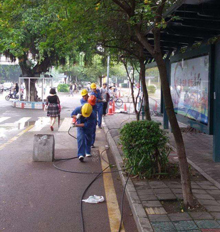The reason of high attenuation during fiber cable installation
There are different reasons to have high attenuation during the fiber cable laying. during which process or what kind of behavior will lead to high fiber cable loss?
1.1Fiber Cabe laying high attenuation
During the fiber optical cable installation, the cable laying length usually has 2-3km which have to pass through many obstacles via many workers, it is difficult to ensure all the laying personnel coordinate well especially pull fiber cable through the pipes, turning, slopes ect, so It is easy to have back buckling which has serious damage to the fiber cables. Once a dead bend occurs, it will inevitably cause the high loss, or partial fiber or all fiber breakdown. Moreover, the fiber cable end is the main part to be damaged during laying, and there will be high attenuation when splicing, and can’t reduce the loss even several times re-splicing.

1.2 fiber cable splicing high attenuation
In the process of optical fiber cable splicing, large attenuation often occurs. We generally use OTDR (optical time domain reflectometer) to monitor every spliced fiber attenuation value, due to the differences in the fiber manufacturing process, the two fibers cannot be completely consistent. There is always a phenomenon of inconsistent mode field diameters, which results in the loss value measured by the OTDR is not a splice loss, the actual loss value is positive or negative. Hence the real time two-way monitoring method is used to ensure that the splice loss reaches the control target.
But the large attenuation point raised due to compressed or with very small bend radius when do the cable storage work after splicing. The fiber 1550nm wavelength is very sensitive to bend and compression, a large attenuation point is formed.
1.3 High attenuations raised during transportation and handling。
The installation environment is usually very harsh especially cabling for the railways, the crane is often unable to reach the cabling site so the cables only can be loaded or unloaded by hands, during the process, the rugged stuff such as rocks of the ground will damage or compress the outer layer fiber cable during rolling if the reel diameter is too small or without wooden package protection due to the factory save material cost to have a high attenuation point.
1.4 The large attenuation point generated during the end process
The other easily neglected reason is that the fiber cable is easy to be twisted and tube deformed which resulted in pressure on fiber when the splice closures and cable fixed while inside the fiber cable is not fixed firmly. The attenuation point is generally concealed, unlike the large attenuation point in the middle of the line that can be directly measured by OTDR.
